General Sir John Monash, Personal Files Book 17, 11 February - 18 March 1918, Part 1
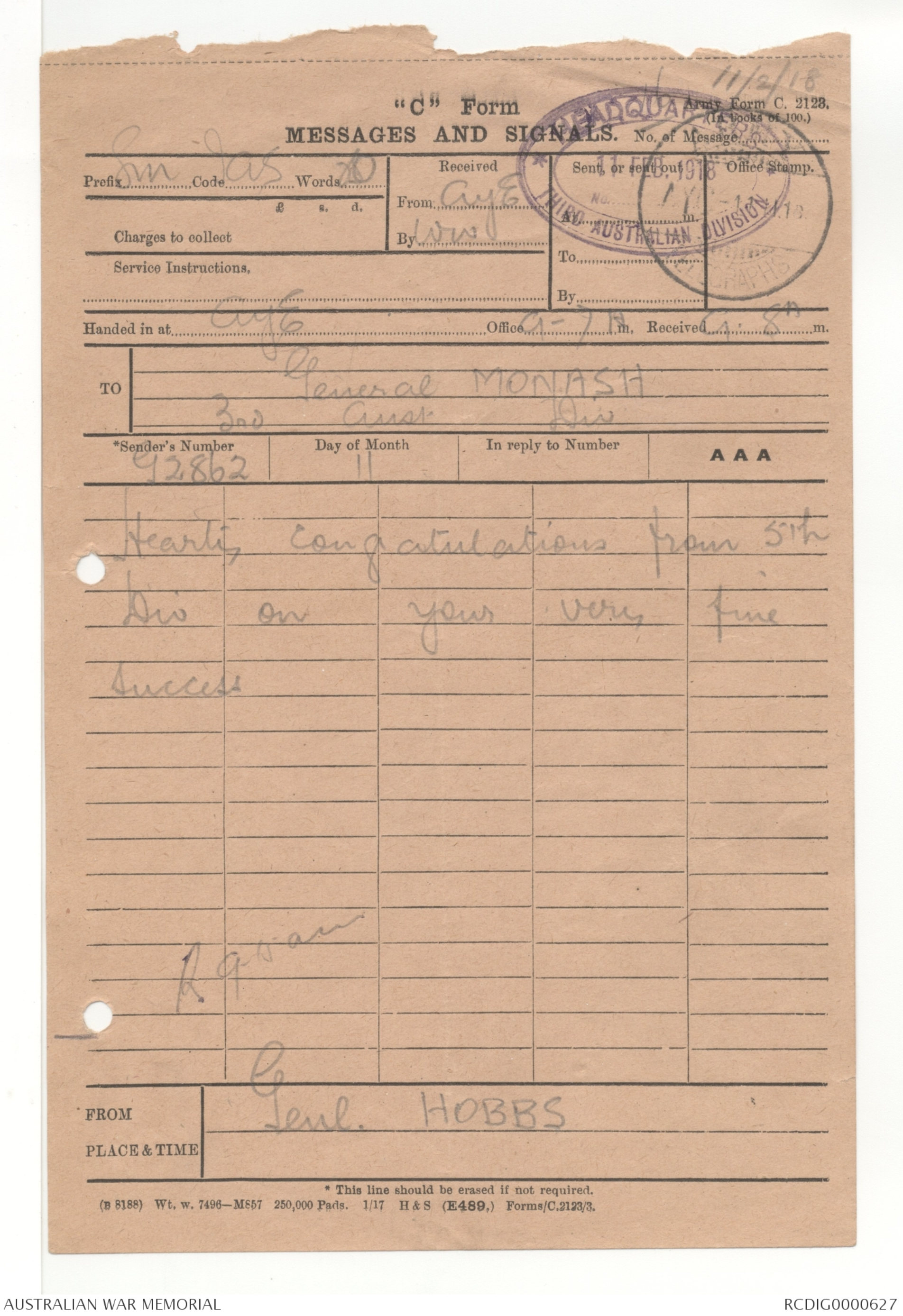
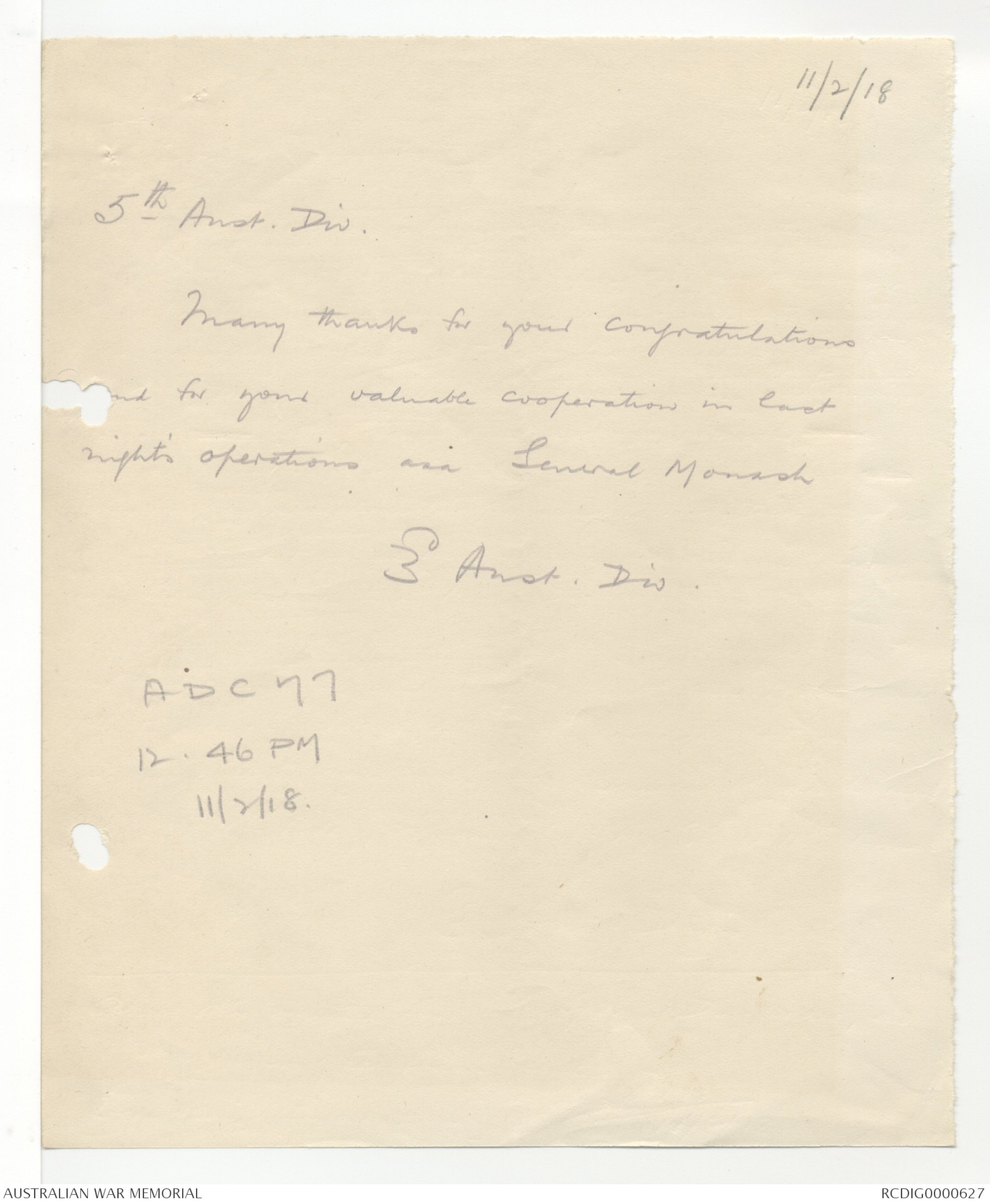
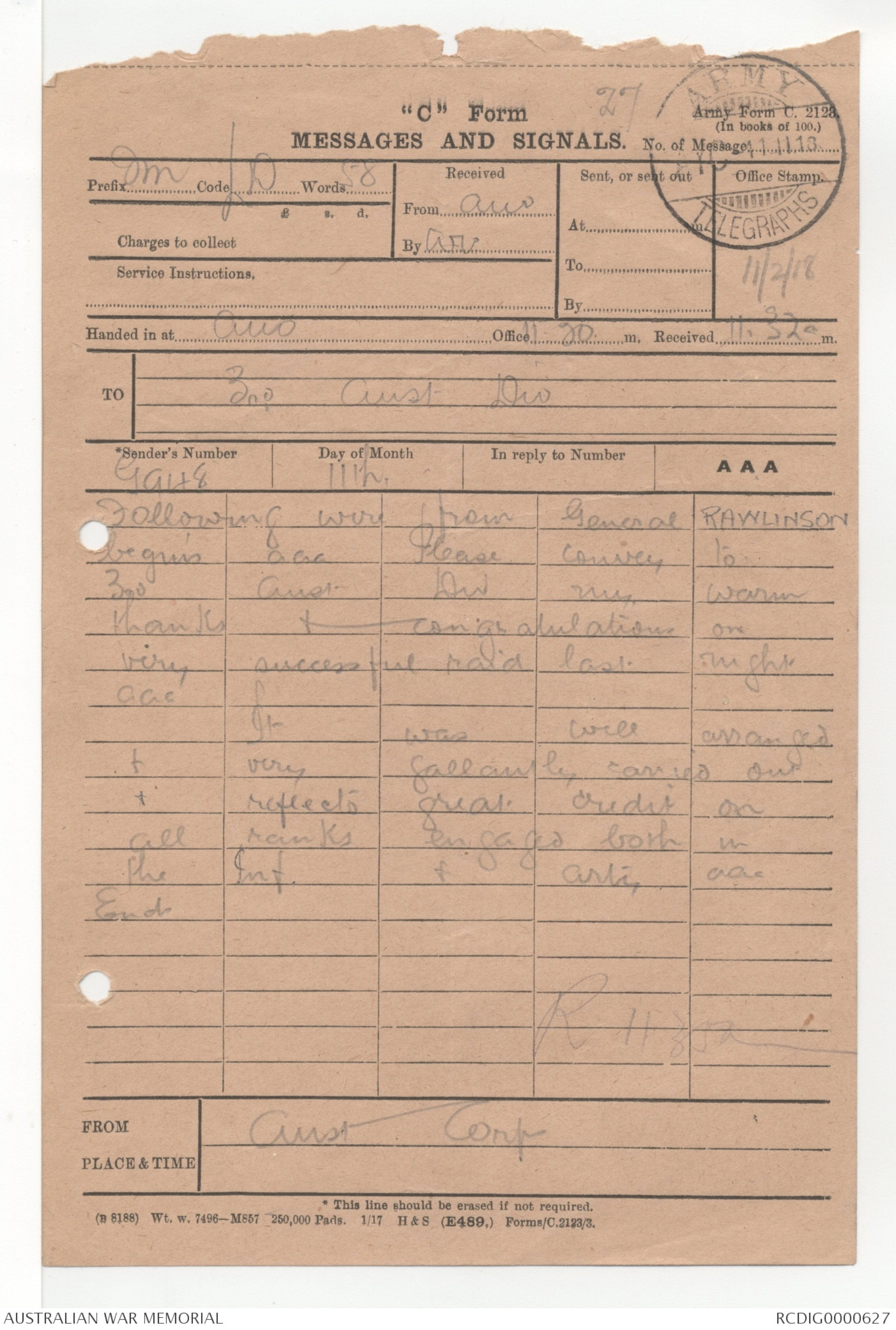
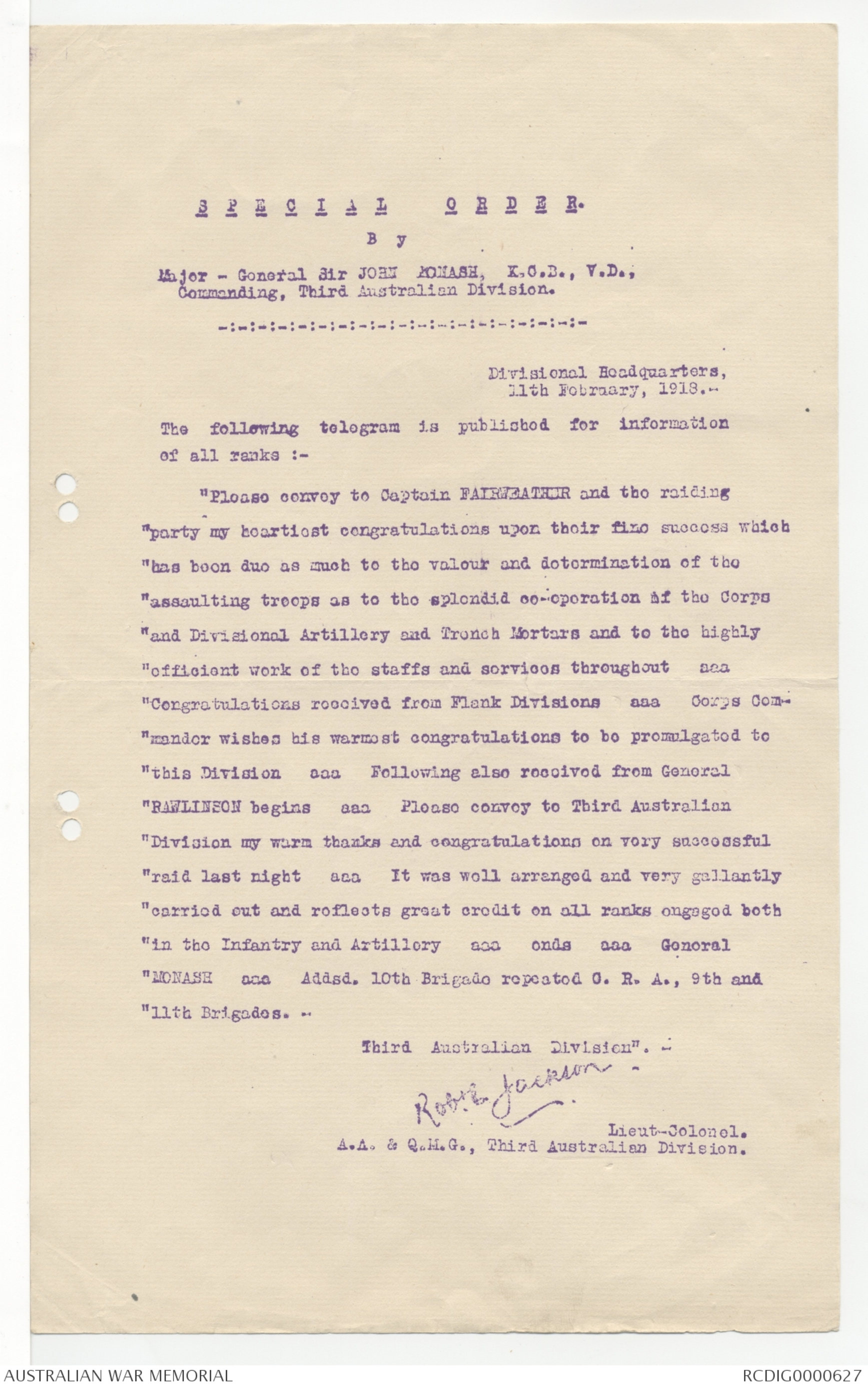
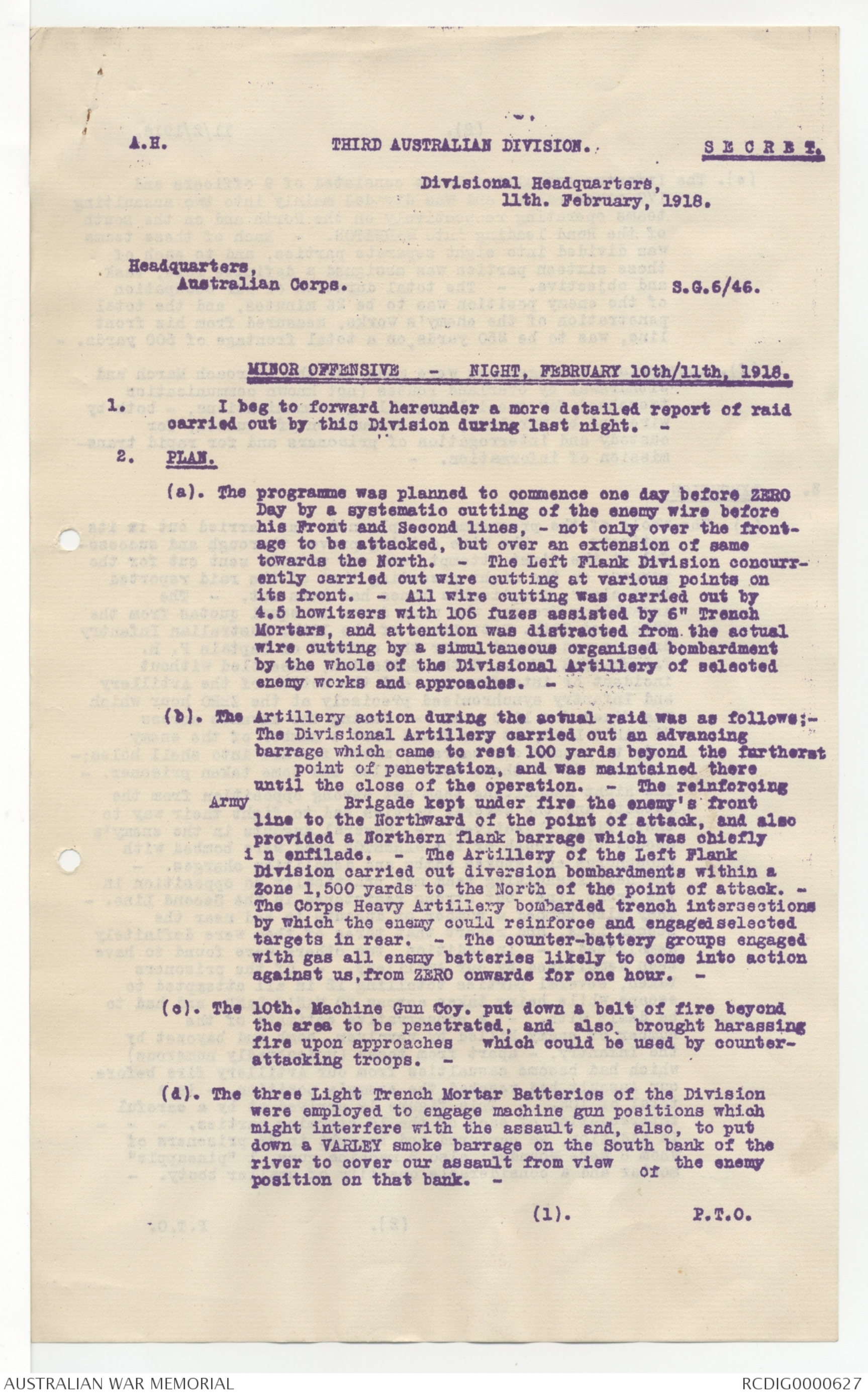
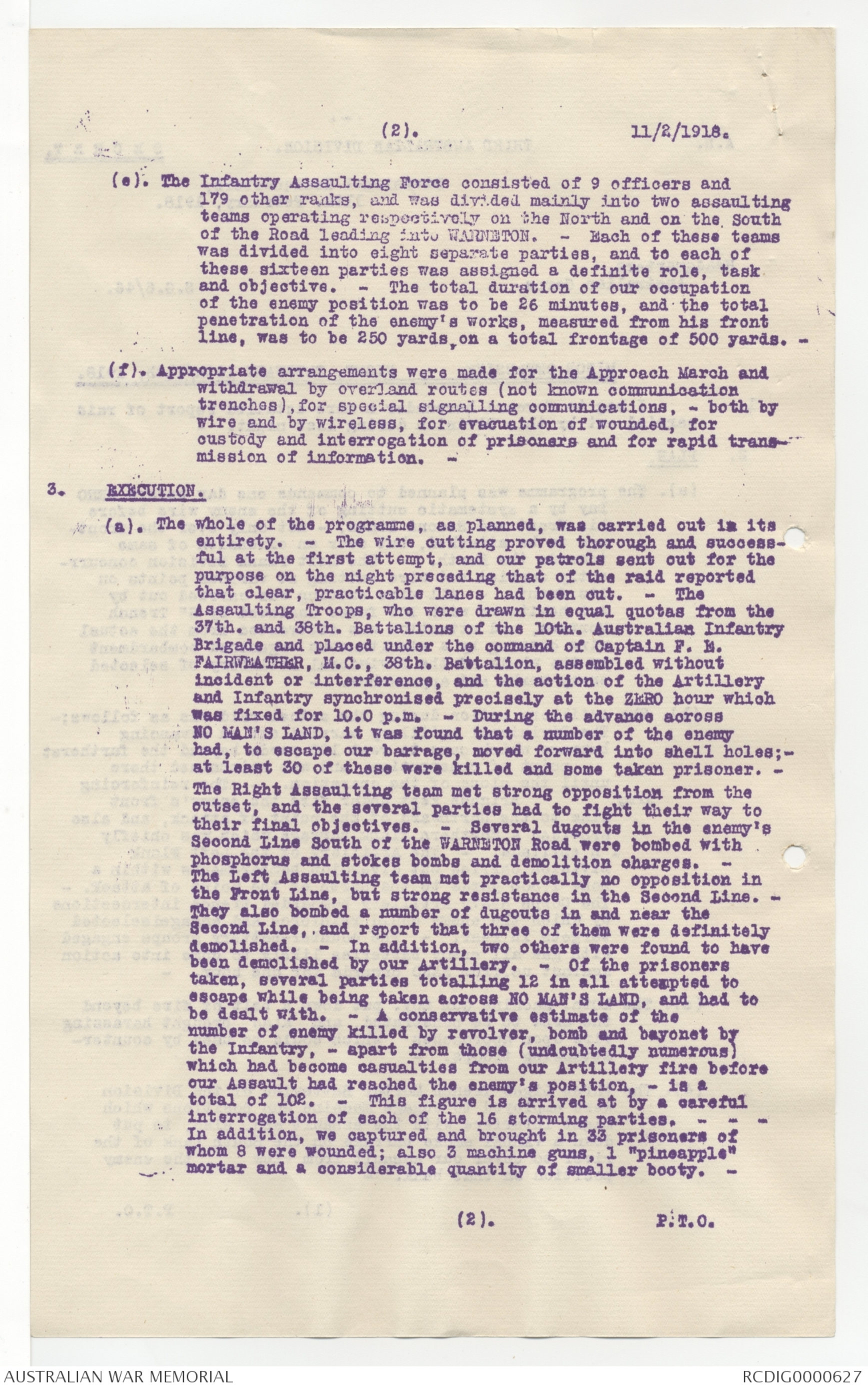
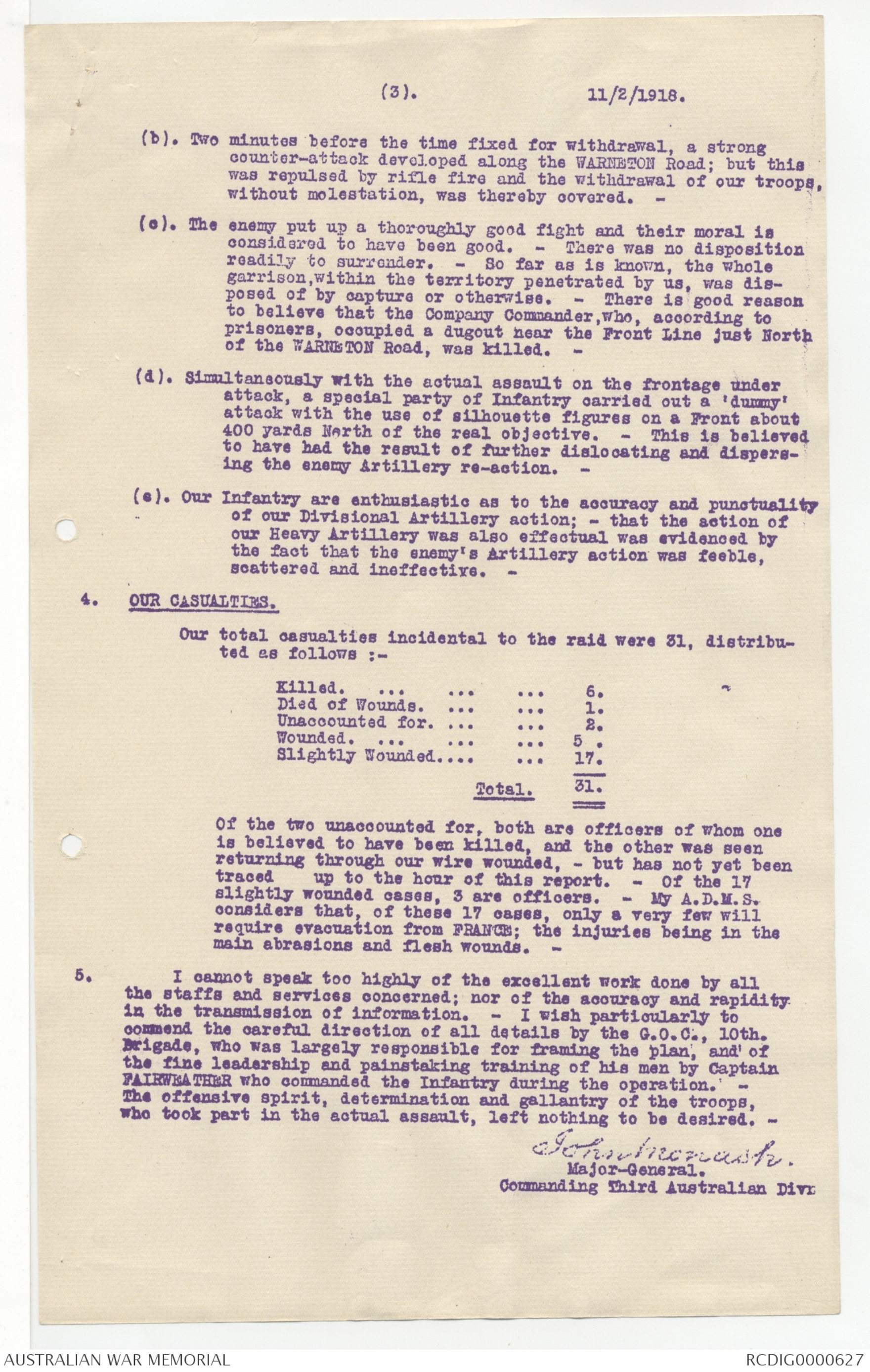

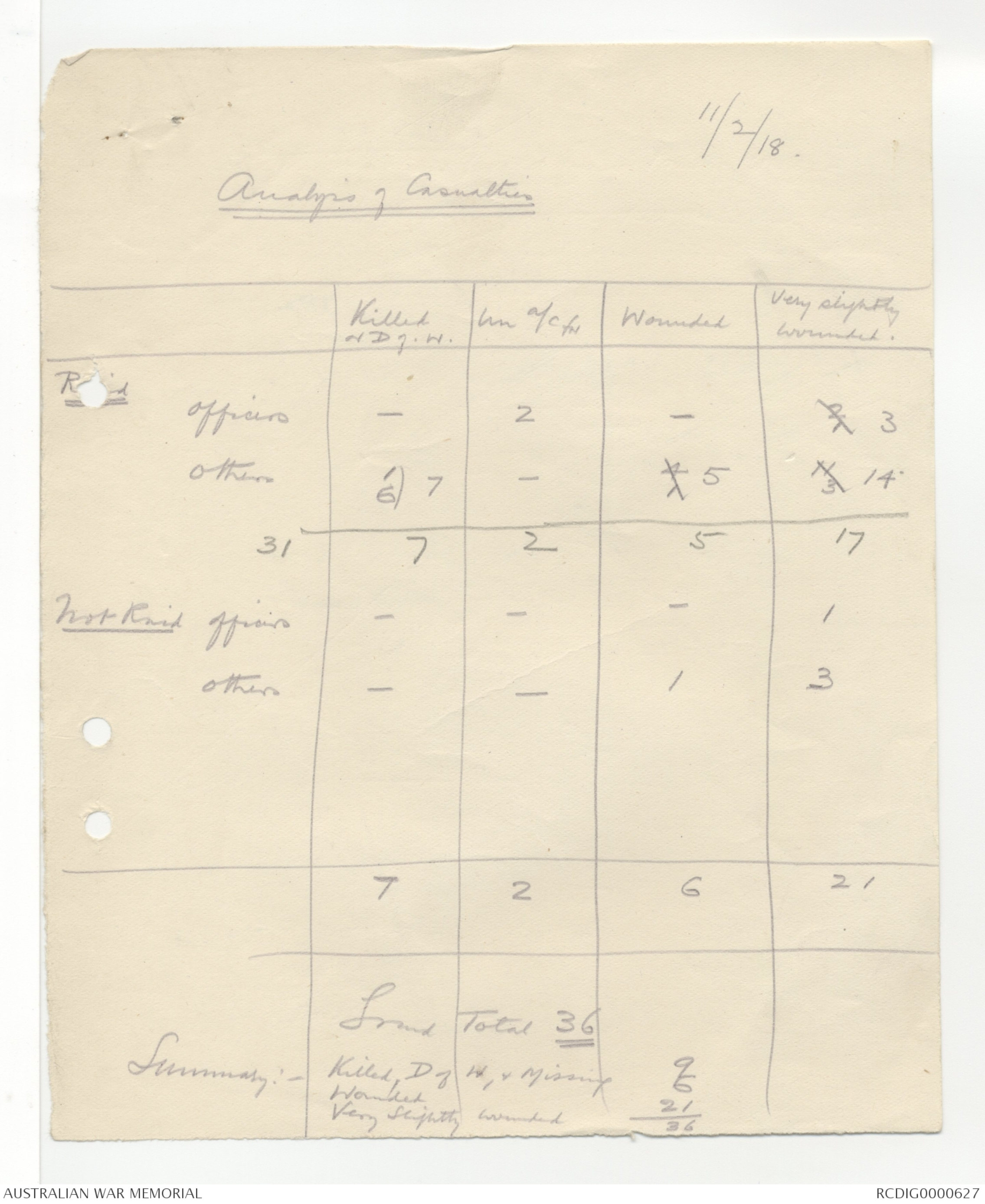
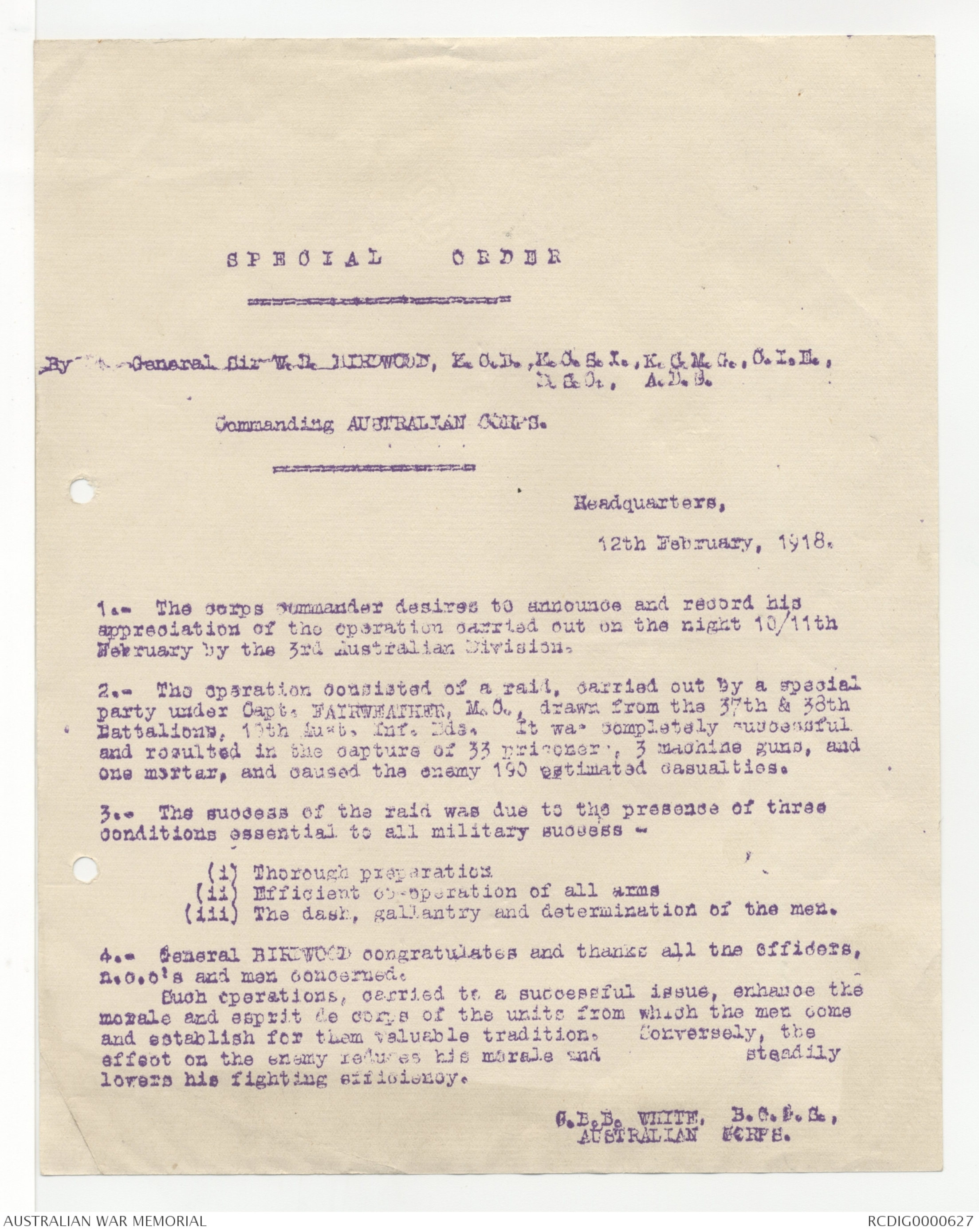
"C" Form 11/2/18
MESSAGES AND SIGNALS
HEADQUARTERS
11 Feb. 1918
THIRD AUSTRALIAN DIVISION
AYC-111118
TELEGRAPHS
Prefix GM Code IAS Words 10
Received
From AYE
By WW
Handed in at AYE Office 9-7 Am Received 9-8 Am.
TO General MONASH
3rd Aust. Div.
Sender's Number G2862
Day of Month 11
Hearty congratulations from 5th
Div on your very fine
success.
R 9.15 a.m.
FROM Genl. HOBBS
11/2/18
5th Aust. Div.
Many thanks for your congratulations
and for your valuable cooperation in last
night's operations aaa General Monash
3rd Aust. Div.
ADC 77
12.46 PM
11/2/18
"C" Form 27
MESSAGES AND SIGNALS
ARMY
AYC 11 11 18
TELEGRAPHS
Prefix DM Code LD Words 58
Received
From Aus
By WV
Sent, or sent out
At
To
By
Office Stamp
11/2/18
Handed in at Aus Office 11.30m, Received 11.32 am.
To 3rd Aust Div
Sender's number G948 Day of Month 11th In reply to Number AAA
Following wire from General RAWLINSON
begins aaa Please convey to
3rd Aust Div my warm
thanks & congratulations on
very successful raid last night
aaa
It was well arranged
& very gallantly carried out
& reflects great credit on
all ranks engaged both in
the Inf. & arty aaa
Ends
R 1135am
FROM Aust Corp
PLACE and TIME
SPECIAL ORDER.
By
Major - General Sir JOHN MONASH, K.O.B, V.D.,
Commanding, Third Australian Division.
Divisional Headquarters,
11th February, 1918.-
The following telegram is published for information
of all ranks:-
"Please convey to Captain FAIRWEATHER and the raiding
"party my heartiest congratulations upon their fine success which
"has been due as much to the valour and determination of the
"assaulting troops as to the splendid co-operation of the Corps
"and Divisional Artillery and Trench Mortars and to the highly
"efficient work of the staff and services throughout aaa
"Congratulations received from Flank Divisions aaa Corps Commander
"wishes his warmest congratulations to be promulgated to
"this Division aaa Following also received from General
"RAWLINSON begins aaa Please convey to Third Australian
"Division my warm thanks and congratulations on very successful
"raid last night aaa It was well arranged and very gallantly
"carried out and reflects great credit on all ranks engaged both
"in the Infantry and Artillery aaa ends aaa General
"MONASH aaa Addsd. 10th Brigade repeated G.R.A., 9th and
"11th Brigades.-
Third Australian Division".-
Robt. E. Jackson
Lieut-Colonel.
A.A. & Q.M.G., Third Australian Division.
A.H. THIRD AUSTRALIAN DIVISION. SECRET.
Divisional Headquarters,
11th. February, 1918.
Headquarters,
Australian Corps. S.G.6/46.
MINOR OFFENSIVE - NIGHT, FEBRUARY 10th/11th, 1918.
1. I beg to forward hereunder a more detailed report of raid
carried out by this Division during last night.-
2. PLAN.
(a). The programme was planned to commence one day before ZERO
Day by a systematic cutting of the enemy wire before
his front and Second lines, - not only over the frontage
to be attacked, but over an extension of same
towards the North. - The Left Flank Division concurrently
carried out wire cutting at various points on
its front. - All wire cutting was carried out by
4.5 howitzers with 106 fuzes assisted by 6" Trench
Mortars, and attention was distracted from the actual
wire cutting by a simultaneous organised bombardment
by the whole of the Divisional Artillery of selected
enemy works and approaches. -
(b). The Artillery action during the actual raid was as follows:-
The Divisional Artillery carried out an advancing
barrage which came to rest 100 yards beyond the fartherst
point of penetration, and was maintained there
until the close of the operation. - The reinforcing
Army Brigade kept under fire the enemy's front
line to the Northward of the point of attack, and also
provided a Northern flank barrage which was chiefly
in enfilade. -The Artillery of the Left Flank
Division carried out diversion bombardment within a
zone 1,500 yards to the North of the point of attack. -
The Corps Heavy Artillery bombarded trench intersections
by which the enemy could reinforce and engaged selected
targets in rear. - The counter-battery groups engaged
with gas all enemy batteries likely to come into action
against us, from ZERO onwards for one hour. -
(c). The 10th. Machine Gun Coy. put down a belt of fire beyond
the area to be penetrated, and also brought harassing
fire upon approaches which could be used by counter-attacking
troops. -
(d). The three Light Trench Mortar Batteries of the Division
were employed to engage machine gun positions which
might interfere with the assault and, also, to put
down a VARLEY smoke barrage on the South bank of the
river to cover our assault from view of the enemy
position on that bank. -
(1). P.T.O.
(2). 11/2/1918
(e). The Infantry Assaulting Forces consisted of 9 officers and
179 other ranks, and was divided mainly into two assaulting
teams operating respectively on the North and on the South
of the Road leading into WARNETON. - Each of these teams
was divided into eight separate parties, and to each of
these sixteen parties was assigned a definite role, task
and objective. - The total duration of our occupation
of the enemy position was to be 26 minutes, and the total
penetration of the enemy's works, measured from his front
line, was to be 250 yards, on a total frontage of 500 yards. -
(f). Appropriate arrangements were made for the Approach March and
withdrawal by overland routes (not known communication
trenches), for special signalling communications, - both by
wire and wireless, for evacuation of wounded, for
custody and interrogation of prisoners and for rapid transmission
of information. -
3. EXECUTION.
(a). The whole of the programme, as planned, was carried out in its
entirety. - The wire cutting proved thorough and successful
at the first attempt, and our patrols sent out for the
purpose of the night preceding that of the raid reported
that clear, practicable lanes had been cut. - The
Assaulting Troops, who were drawn in equal quotas from the
37th. and 38th. Battalions of the 10th. Australian Infantry
Brigade and placed under the command of Captain F.E.
FAIRWEATHER, M.C., 38th. Battalion, assembled without
incident or interference, and the action of the Artillery
and Infantry synchronised precisely at the ZERO hour which
was fixed for 10.0 p.m. - During the advance across
NO MAN'S LAND, it was found that a number of the enemy
had, to escape our barrage, moved forward into shell holes;-
at least 30 of these were killed and some taken prisoner. -
The Right Assaulting team met strong opposition from the
outset, and the several parties had to fight their way to
their final objectives. - Several dugouts in the enemy's
Second Line South of the WARNETON Road were bombed with
phosphorus and stokes bombs and demolition charges. -
The Left Assaulting team met practically no opposition in
the Front Line, but strong resistance in the Second Line. -
They also bombed a number of dugouts in and near the
Second Line, and report that three of them were definitely
demolished. - In addition, two others were found to have
been demolished by our Artillery. - Of the prisoners
taken, several parties totalling 12 in all attempted to
escape while being taken across NO MAN'S LAND, and had to
be dealt with. - A conservative estimate of the
number of enemy killed by revolver, bomb and bayonet by
the Infantry, - apart from those (undoubtedly numerous)
which had become casualties from our Artillery fire before
our Assault had reached the enemy's position, - is a
total of 102. - This figure is arrived at by a careful
interrogation of each of the 16 storming parties. - - -
In addition, we captured and brought in 33 prisoners of
whom 8 were wounded; also 3 machine guns, 1 "pineapple"
mortar and a considerable quantity of smaller booty. -
(2). P.T.O.
(3). 11/2/1918
(b). Two minutes before the time fixed for withdrawal, a strong
counter-attack developed along the WARNETON Road; but this
was repulsed by rifle fire and the withdrawal of our troops,
without molestation, was thereby covered. -
(c). The enemy put up a thoroughly good fight and their moral is
considered to have been good. - There was no disposition
readily to surrender. - So far as is known, the whole
garrison, within the territory penetrated by us, was disposed
of by capture or otherwise. - There is good reason
to believe that the Company Commander, who, according to
prisoners, occupied a dugout near the Front Line just North
of the WARNETON Road, was killed. -
(d). Simultaneously with the actual assault of the frontage under
attack, a special party of Infantry carried out a 'dummy'
attack with the use of silhouette figures on a Front about
400 yards North of the real objective. - This is believed
to have had the result of further dislocating and dispersing
the enemy Artillery re-action. -
(e). Our Infantry are enthusiastic as to the accuracy and punctuality
of our Divisional Artillery action; - that the action of
our Heavy Artillery was also effectual was evidenced by
the fact that the enemy's Artillery action was feeble,
scattered and ineffective. -
4. OUR CASUALTIES
Our total casualties incidental to the raid were 31, distributed
as follows:-
Killed. 6.
Died of Wounds. 1.
Unaccounted for. 2.
Wounded. 5.
Slightly wounded. 17.
Total. 31.
Of the two unaccounted for, both are officers of whom one
is believed to have been killed, and the other was seen
returning through our wire wounded, - but has not yet been
traced up to the hour of this report. - Of the 17
slightly wounded cases, 3 are officers. - My A.D.M.S.
considers that, of these 17 cases, only a very few will
require evacuation from FRANCE; the injuries being in the
main abrasions and flesh wounds. -
5. I cannot speak too highly of the excellent work done by all
the staffs and services concerned; nor of the accuracy and rapidity
in the transmission of information. - I wish particularly to
commend the careful direction of all details by the G.O.C., 10th.
Brigade, who was largely responsible for framing the plan, and of
the fine leadership and painstaking training of his men by Captain
FAIRWEATHER who commanded the Infantry during the operation. -
The offensive spirit, determination and gallantry of the troops,
who took part in the actual assault, left nothing to be desired. -
John Monash.
Major-General.
Commanding Third Australian Divn
THIRD AUSTRALIAN DIVISION
3rd AUSTRALIAN DIVISION
No M1/2/1
A.D.M.S. BRANCH
Headquarters,
11th. February, 1918
To,
Headquarters, "G"
Casualties from 10th.Inf.Brigade Raid -10.2.1918.
Lieut. SCHILTZ 38th.Battalion - shell wd.both legs.
" HUNTER 37th. do. - Wd. R.side and thigh.
" JOHNSON 37th. do. - Wd. L. thigh.
" WHITTINGHAM 11th. L.T.M.B. - Wd. buttock, abrasions face
and frac. thumb.
(All slight wounds - none serious.)
Other ranks - 24.
Prisoners - 8.
TOTAL (including prisoners) - 36.
[[Signed?]]
COLONEL.
A.D.M.S. Third Australian Division.
FAM/FGL.
CASUALTIES
37th. Battalion.
Died 1
Serious 4
Slight 13 -(2) 18
38th.Battalion
Serious 1
Slight 4 -(1) 5
Total for Raiding Party. 23
Classification of Wounds: -
Died - 1
Serious - 5
Slight - 17 (12 very slight
not ev from France)
Other casualties.
39th.Battalion
Serious - 1
Slight - 3
11th.T.M.B. Slight - 1 TOTAL. 28.
11/2/18
Analysis of Casualties
| Killed or D of. W. |
Un a/c for | Wounded | Very slightly wounded |
||
| Raid | Officers | - | 2 | - | |
| Others | 1) 6) 7 |
- | |||
| 31 | 7 | 2 | 5 | 17 | |
| Not Raid | Officers | - | - | - | 1 |
| Others | - | - | 1 | 3 | |
| 7 | 2 | 6 | 21 |
Grand total 36
Summary:- Killed, D of W, & missing 9
Wounded 6
Very slightly wounded 21
36
SPECIAL ORDER
By General Sir W.B. BIRDWOOD, K.C.B., K.C.S.I., K.G.M.G., C.I.E.,
D.S.O., A.D.B.
Commanding AUSTRALIAN CORPS.
Headquarters,
12th February, 1918.
1.- The corps commander desires to announce and record his
appreciation of the operation carried out on the night 10/11th
February by the 3rd Australian Division.
2.- The operation consisted of a raid, carried out by a special
party under Capt. FAIRWEATHER, M.C., drawn from the 37th & 38th
Battalions, 19th Aust. Inf. Bde. It was completely successful
and resulted in the capture of 33 prisoners, 3 machine guns, and
one mortar, and caused the enemy 190 estimated casualties.
3.- The success of the raid was due to the presence of three
conditions essential to all military success -
(i) Thorough preparation
(ii) Efficient co-operation of all arms
(iii) The dash, gallantry and determination of the men.
4.- General BIRDWOOD congratulates and thanks all the officers,
n.c.o.'s and men concerned.
Such operations, carried to a successful issue, enhance the
morale and esprit de corps of the units from which the men come
and establish for them valuable tradition. Conversely, the
effect on the enemy reduces his morale and steadily
lowers his fighting efficiency.
C.B.B. WHITE, B.C.D.B.
AUSTRALIAN CORPS.
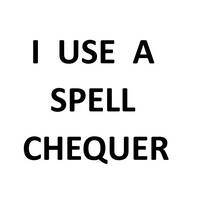 Not Yet Replaced By AI
Not Yet Replaced By AIThis transcription item is now locked to you for editing. To release the lock either Save your changes or Cancel.
This lock will be automatically released after 60 minutes of inactivity.